In this Article:
Try Kanbanchi now
Start your free trial
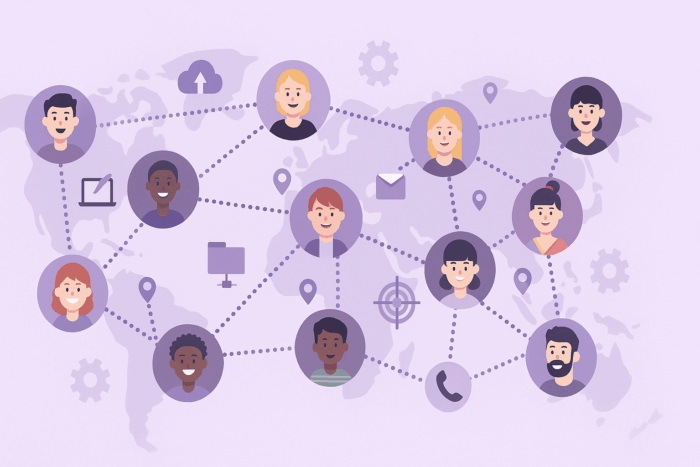
As we navigate 2025, remote work has evolved from a pandemic necessity to a permanent business strategy. With 22.8% of the US workforce (approximately 32.6 million Americans) now working remotely, and distributed teams spanning multiple time zones, organizations need more than basic project management tools. They require specialized remote team management software designed for the complexities of asynchronous communication and distributed work environments.
The transformation is remarkable. While remote work adoption stabilized around 23% after the initial pandemic surge, the challenges of managing cross-timezone collaboration, maintaining team cohesion, and ensuring productivity across distributed teams have intensified. Modern remote team management platforms must address unique challenges: coordinating across 15+ time zones, enabling effective asynchronous communication, and maintaining team culture when face-to-face interactions are limited.
The best remote team management software goes far beyond traditional project management capabilities. While conventional PM tools focus on task tracking and deadline management, specialized remote team management platforms address the unique challenges of distributed work environments.
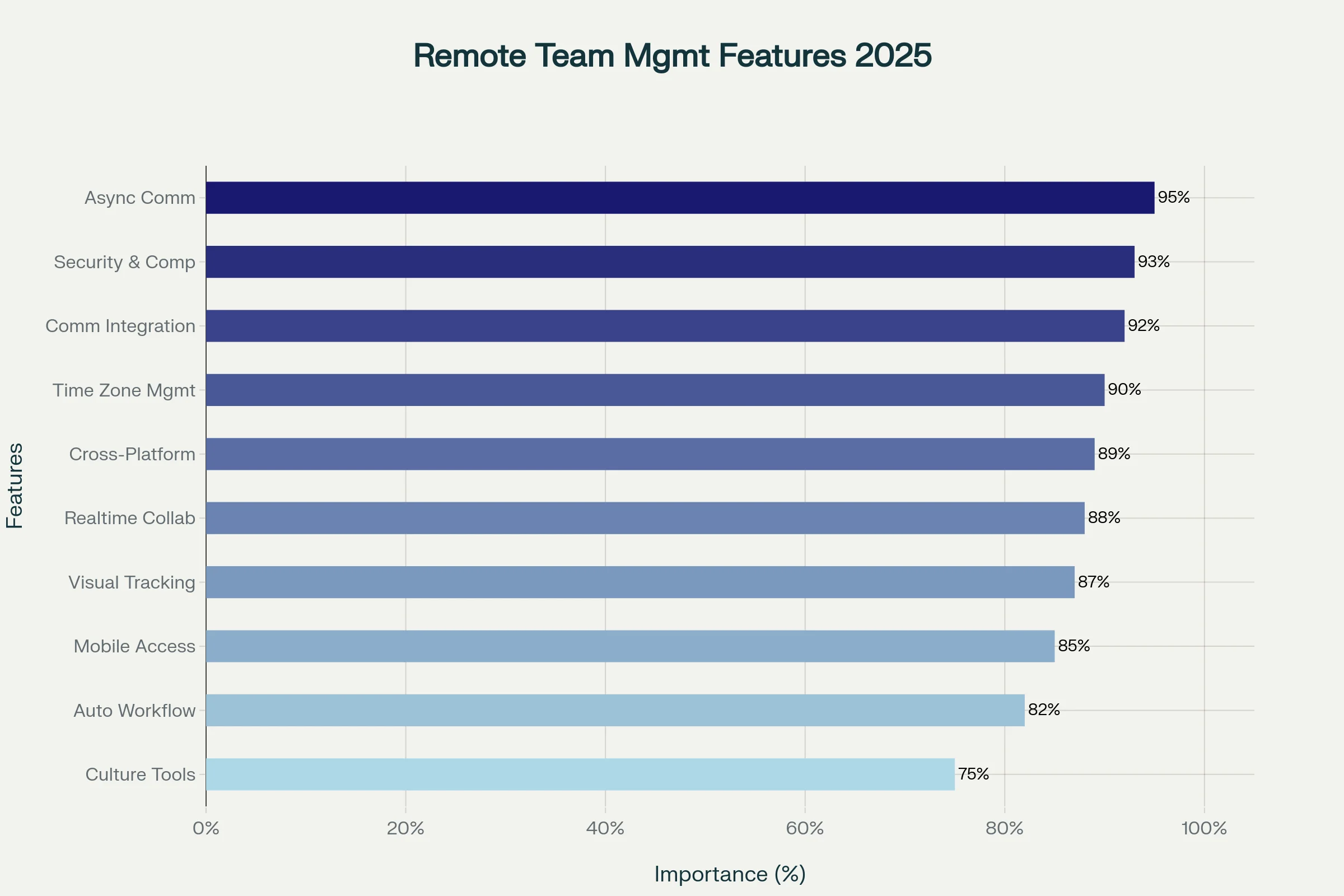
Essential features ranked by importance for effective remote team management software in 2025
Asynchronous Communication Capabilities top the list of essential features, with 95% of distributed teams prioritizing tools that support non-real-time collaboration. Unlike synchronous communication that requires simultaneous availability, asynchronous tools enable team members to contribute meaningfully across different time zones and work schedules.
Time Zone Coordination and Scheduling features automatically adjust deadlines, meeting times, and task handoffs based on team members’ locations. Advanced platforms provide visual time zone maps and suggest optimal collaboration windows when global team members can overlap.
Visual Project Tracking becomes crucial when teams can’t gather for impromptu status meetings. Modern remote team collaboration tools offer multiple view options: Kanban boards, Gantt charts, and overviews. They ensure project visibility regardless of when team members access the system.
Integration With Remote Work Ecosystems distinguishes excellent platforms from basic alternatives. The most effective solutions seamlessly integrate with popular cloud storage services (Google Drive, OneDrive, SharePoint) to create unified workflows.
Mobile Synchronization ensures productivity continues even with intermittent connectivity.
Security and Compliance Features rank equally important, with 93% of organizations requiring enterprise-grade protection for sensitive data shared across distributed teams. This includes end-to-end encryption, single sign-on (SSO), and permission controls that maintain security without impeding collaboration.
The distinction between general project management and specialized remote team software lies in how these features work together to address the human element of distributed work, building trust, maintaining culture, and ensuring every team member feels connected and valued regardless of their physical location.
More articles about Remote Work here
Kanbanchi stands out as the premier remote team management software for organizations leveraging Google Workspace, offering unparalleled integration that transforms how distributed teams collaborate. Unlike standalone tools that require separate logins and data silos, Kanbanchi becomes a native part of your Google ecosystem, storing project boards directly in Google Drive with the same security and accessibility that your team already trusts.
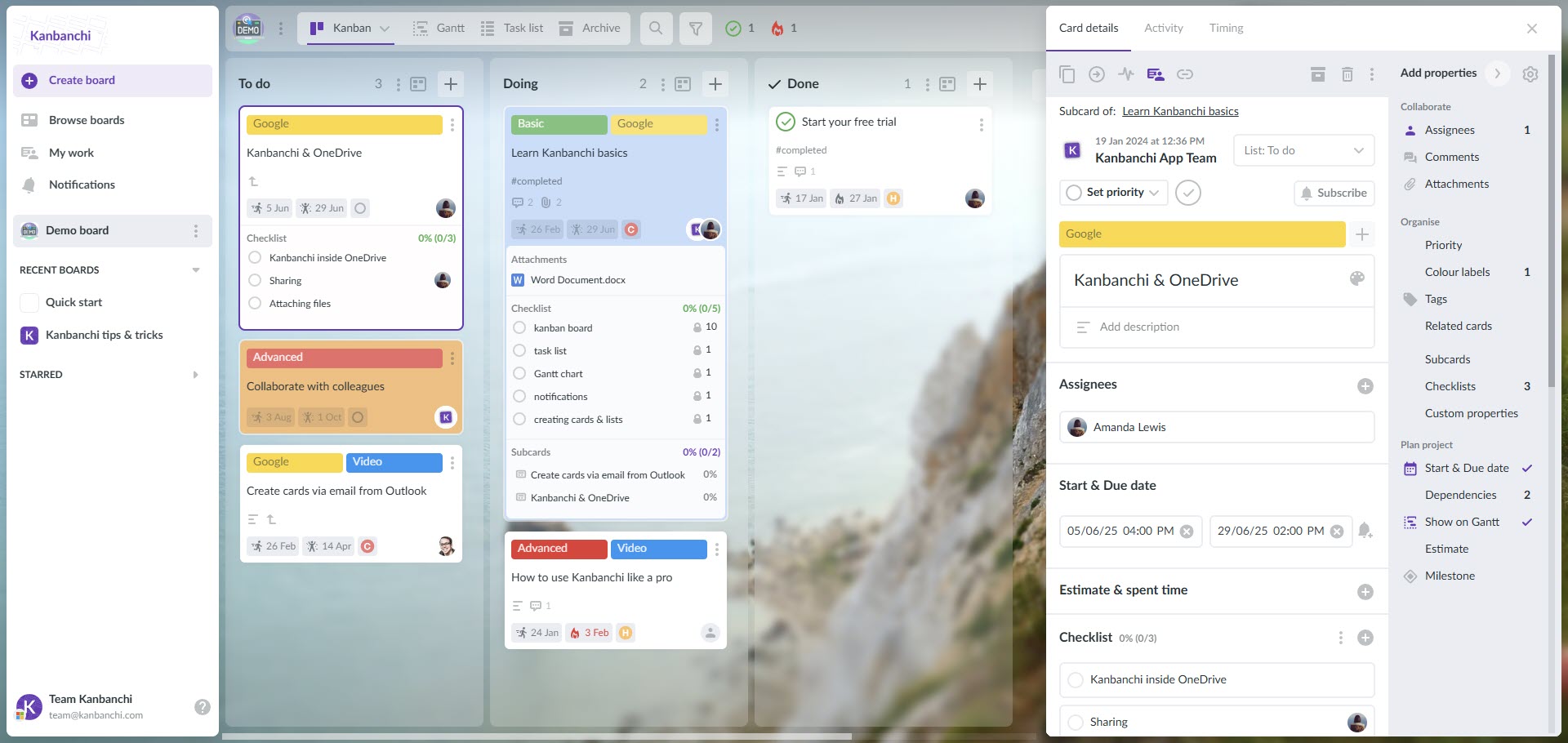
The same applies to the Microsoft environment. Kanbanchi for MS utilizes Microsoft accounts to log you in to the system, storing files (including project boards) on OneDrive or SharePoint. This is the ideal solution for larger companies that require an extra layer of security.
Native Google Workspace/Microsoft 365 Integration: Sign up with your Google or Microsoft account, create tasks from Gmail or Outlook, and share boards like any Google Drive, OneDrive, or SharePoint file -no learning curve required
Real-time Kanban Board Collaboration: Multiple team members can update boards simultaneously, with changes syncing instantly across all time zones
Integrated Time Tracking: Monitor project progress and team productivity with built-in time tracking that exports directly to Google Sheets/CSV for reporting
Cross-timezone Calendar Sync: Tasks and deadlines can be added to Google Calendar with proper time zone adjustments for each team member
Asynchronous Task Updates: Team members can leave detailed comments, attach files from Google Drive, OneDrive or SharePoint, and update progress without disrupting others’ workflows
Zero learning curve for Google Workspace users – familiar interface and navigation
Exceptional security with Google’s enterprise-grade encryption and compliance certifications (SOC2 Type II, ISO-27001)
Seamless file attachment from Google Drive, Shared Drives, OneDrive, or SharePoint eliminates version control issues
Gmail integration and Board emails allow creating tasks directly from emails, streamlining workflow management for users from both Google and Microsoft environments
Professional plans may not be affordable for small teams
Customer Rating: 4.6/5 (Google Workspace Marketplace)
Free Trial: Full-featured free plan available
Starting Price: Free for core features; Higher plans from $3.97/user/month
Key Integrations: Google Calendar, Gmail, Google Drive, Google Forms, Google Sheets, OneDrive, SharePoint, Outlook
Best For: Small to medium teams who need visual project management with seamless collaboration across time zones
Kanbanchi’s strength lies in its ability to enhance rather than replace existing Google or Microsoft workflows. Remote teams particularly benefit from the platform’s approach to asynchronous collaboration. Team members can contribute to projects on their schedule while maintaining visibility across the entire organization.
Asana has emerged as a powerful remote project management tool that strikes a balance between simplicity and sophisticated features, making it ideal for teams transitioning to distributed work environments. The platform excels at creating structured workflows that keep remote teams aligned on priorities and deadlines without requiring constant check-ins.
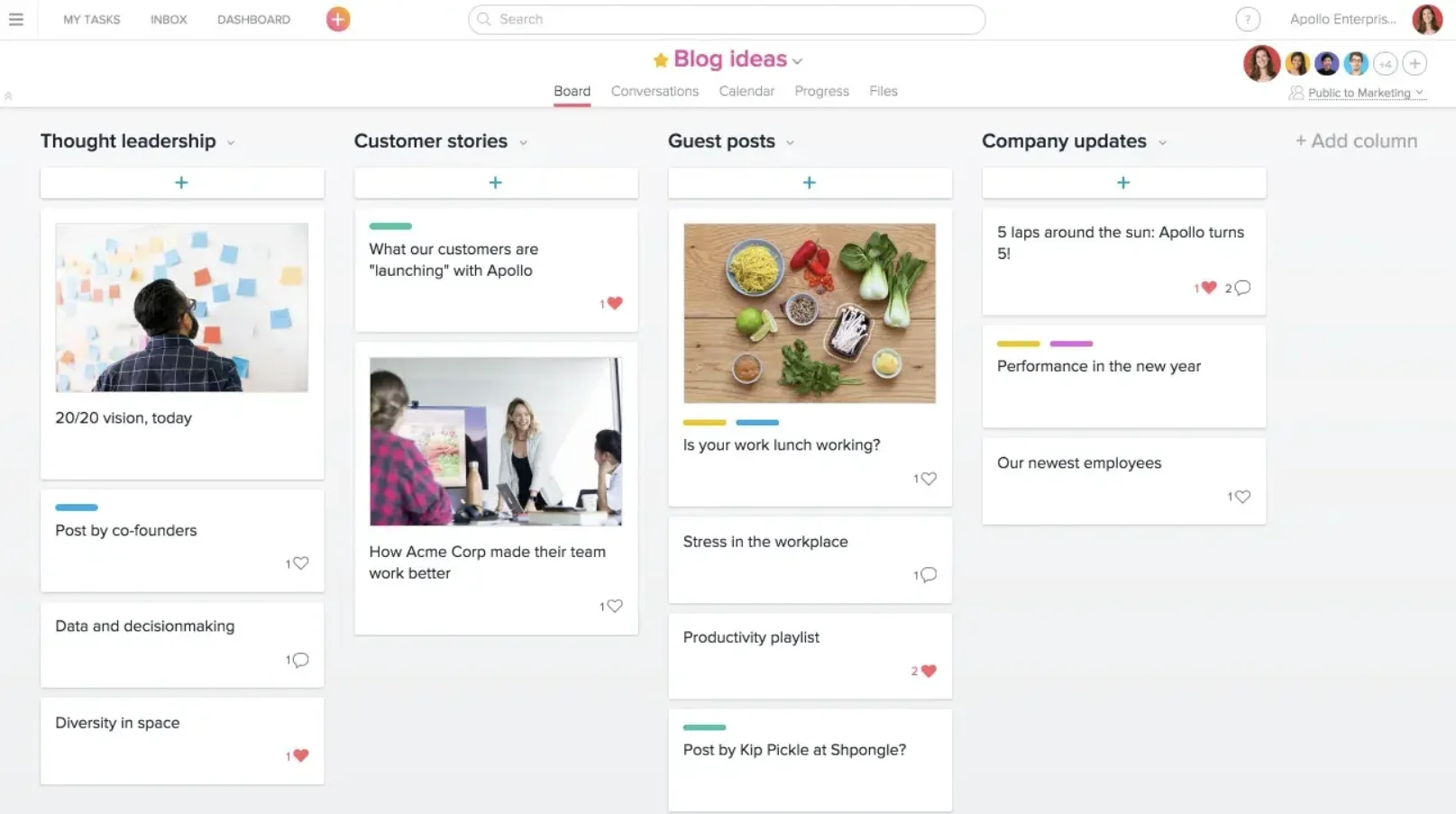
Multiple Project Views: Switch between lists, boards, timeline, and calendar views to match different team preferences and project types
Advanced Automation: Reduce manual work with rule-based automation that moves tasks, updates status, and assigns work based on triggers
Proofing and Review Tools: Enable async feedback on creative assets with markup tools and approval workflows
Portfolio Management: Track multiple projects across teams with executive dashboards and progress reporting
Goal Tracking: Align daily tasks with company objectives through integrated goal-setting and progress monitoring
Intuitive interface that’s easy for new remote team members to adopt quickly
Robust free plan supports teams of up to 15 members with core project management features
Advanced search and reporting help managers track distributed team performance
Advanced features like timeline view and custom fields require paid plans
It can become overwhelming for simple projects that don’t need extensive structure
Time tracking requires third-party integrations or manual logging
Customer Rating: 4.5/5 (G2)
Free Trial: Permanent free plan for small teams
Starting Price: $10.99/user/month for the Starter plan
Key Integrations: Slack, Google Workspace, Microsoft Teams, Adobe Creative Cloud, Salesforce, Zoom
Best For: Growing remote teams needing structured project workflows with clear accountability and progress tracking
Monday.com has established itself as the go-to remote team collaboration tool for creative and marketing teams who thrive on visual organization and colorful, intuitive interfaces. The platform’s strength lies in making complex project data immediately understandable through visual workflows and customizable boards.
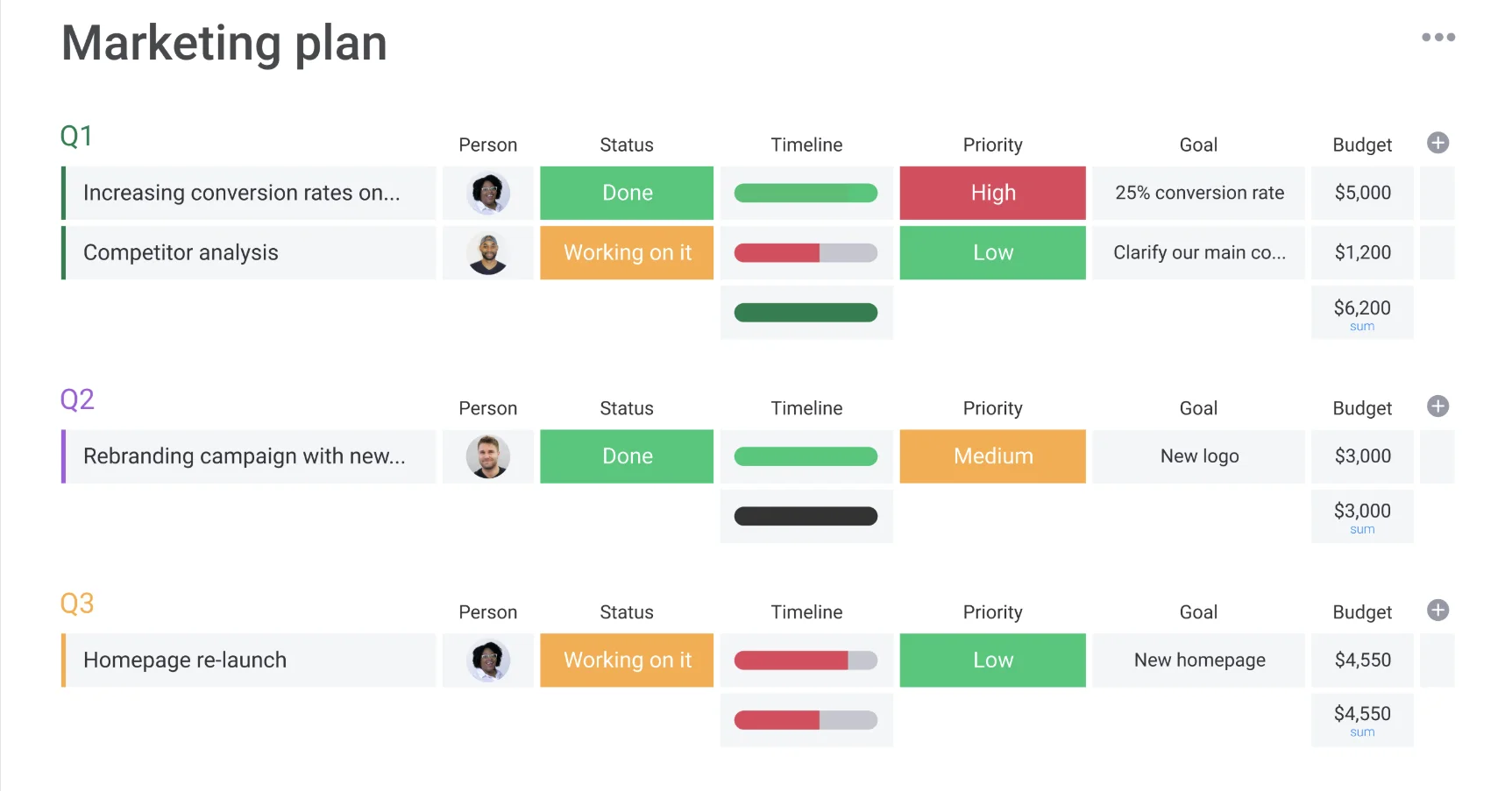
Color-Coded Visual Workflows: Status updates, priority levels, and project phases use visual cues that transcend language barriers
Advanced Automation: Create sophisticated workflow automation with conditional logic and multi-step processes
Time Tracking Integration: Built-in time tracking with visual reporting shows team productivity across different time zones
Client Collaboration: External stakeholder access with permission controls enables seamless client involvement
Resource Management: Visual workload management prevents team burnout by showing capacity across distributed teams
Exceptionally intuitive interface reduces onboarding time for remote team members
Highly customizable boards adapt to any team’s unique workflow requirements
Strong mobile app maintains full functionality for remote work scenarios
Built-in forms and client portals streamline external stakeholder communication
The limited free plan restricts teams to basic features only
Pricing can become expensive as teams scale and add premium features
Learning curve increases significantly when utilizing advanced customization options
Customer Rating: 4.7/5 (Capterra)
Free Trial: 14-day free trial plus a limited free plan
Starting Price: $10/user/month for the Basic plan
Key Integrations: Microsoft Teams, Google Workspace, Zoom, Adobe Creative Cloud, Salesforce, Slack
Best For: Creative and marketing teams needing visual project organization with strong client collaboration capabilities
ClickUp positions itself as the distributed team management solution that replaces multiple tools with one comprehensive platform. While this approach offers incredible flexibility, it also introduces complexity that remote teams must navigate carefully to realize the platform’s potential fully.
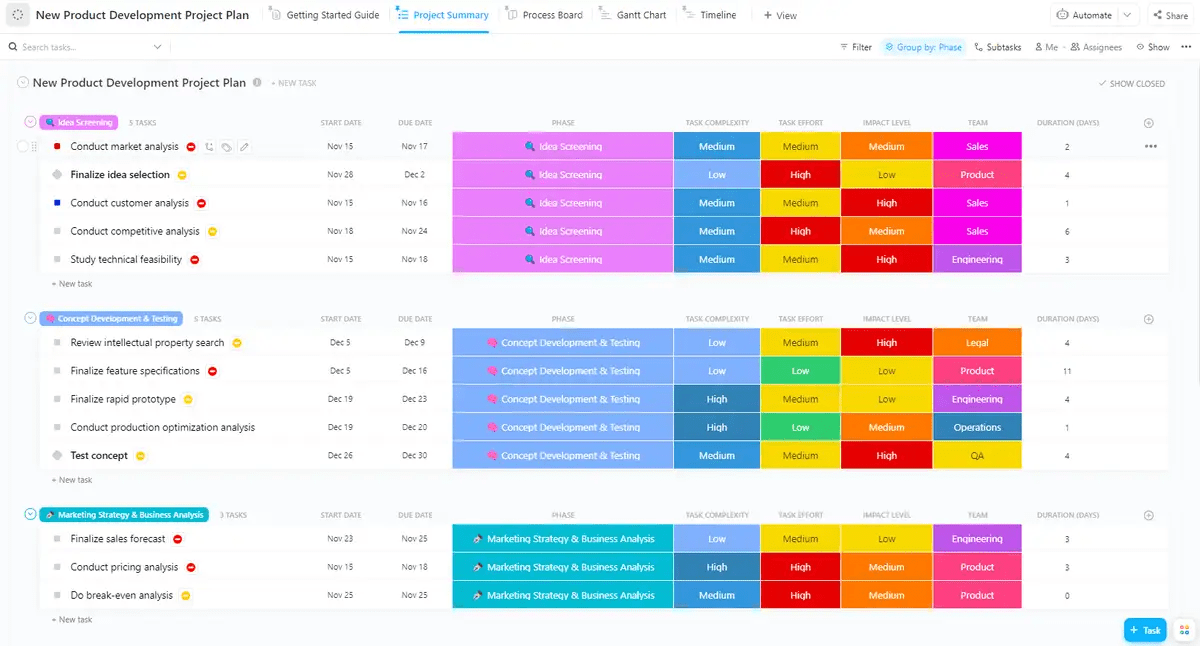
Comprehensive View Options: Choose from 15+ project views, including Kanban, Gantt, calendar, timeline, workload, and mind maps
Integrated Document Hub: Create, share, and collaborate on documents within the same platform as task management
Advanced Time Tracking: Multi-device time tracking with detailed reporting and productivity insights
Custom Automation: Build complex workflow automation with triggers, conditions, and actions across projects
Whiteboard Collaboration: Real-time collaborative whiteboards for brainstorming and planning sessions
Generous free plan includes most core features for unlimited users
Incredible customization allows teams to tailor the platform to their exact needs
All-in-one approach reduces tool switching and integration complexity
Strong API enables custom integrations and workflow extensions
Comprehensive mobile app supports full remote work functionality
Steep learning curve due to the extensive feature set can overwhelm new users
Performance issues are reported with large data sets and complex configurations
Customer support quality varies significantly based on plan level
Customer Rating: 4.6/5 (G2)
Free Trial: Forever free plan available
Starting Price: $7/user/month for Unlimited plan
Key Integrations: Slack, Google Workspace, Microsoft Teams, GitHub, Zoom, Zapier (1000+ apps)
Best For: Technical teams and organizations wanting to replace multiple tools with one comprehensive remote work platform
Trello’s strength lies in its simplicity – a virtual team management solution that transforms complex projects into intuitive visual boards that any remote team member can understand immediately. The platform excels when teams need clear, uncomplicated organization without overwhelming feature sets.

Intuitive Board System: Cards, lists, and boards create an immediately understandable project organization
Power-Ups Ecosystem: Extend functionality with calendar integration, time tracking, and automation add-ons
Mobile-First Design: A fully functional mobile experience enables productivity from any location
Simple Collaboration: Comment threads, file attachments, and @mentions facilitate async communication
Butler Automation: No-code automation rules handle repetitive tasks and status updates
Minimal learning curve makes onboarding remote team members effortless
Free plan provides robust functionality for small distributed teams
Excellent mobile app ensures full access during remote work situations
Clean, distraction-free interface keeps teams focused on actual work
Affordable pricing structure scales well with growing remote teams
Limited advanced features compared to comprehensive project management platforms
Reporting and analytics capabilities require Power-Up add-ons
Not suitable for complex project workflows requiring detailed tracking
Customer Rating: 4.4/5 (G2)
Free Trial: Permanent free plan available
Starting Price: $5/user/month for Standard plan
Key Integrations: Google Workspace, Microsoft Teams, Slack, Dropbox, OneDrive, Zapier
Best For: Small remote teams preferring visual simplicity over feature complexity, exceptionally creative, and marketing teams
Slack revolutionized remote team communication by organizing conversations into channels, transforming chaotic email threads into structured, searchable discussions. While primarily a communication tool, its extensive integration ecosystem makes it a central hub for asynchronous communication tools and remote work coordination.
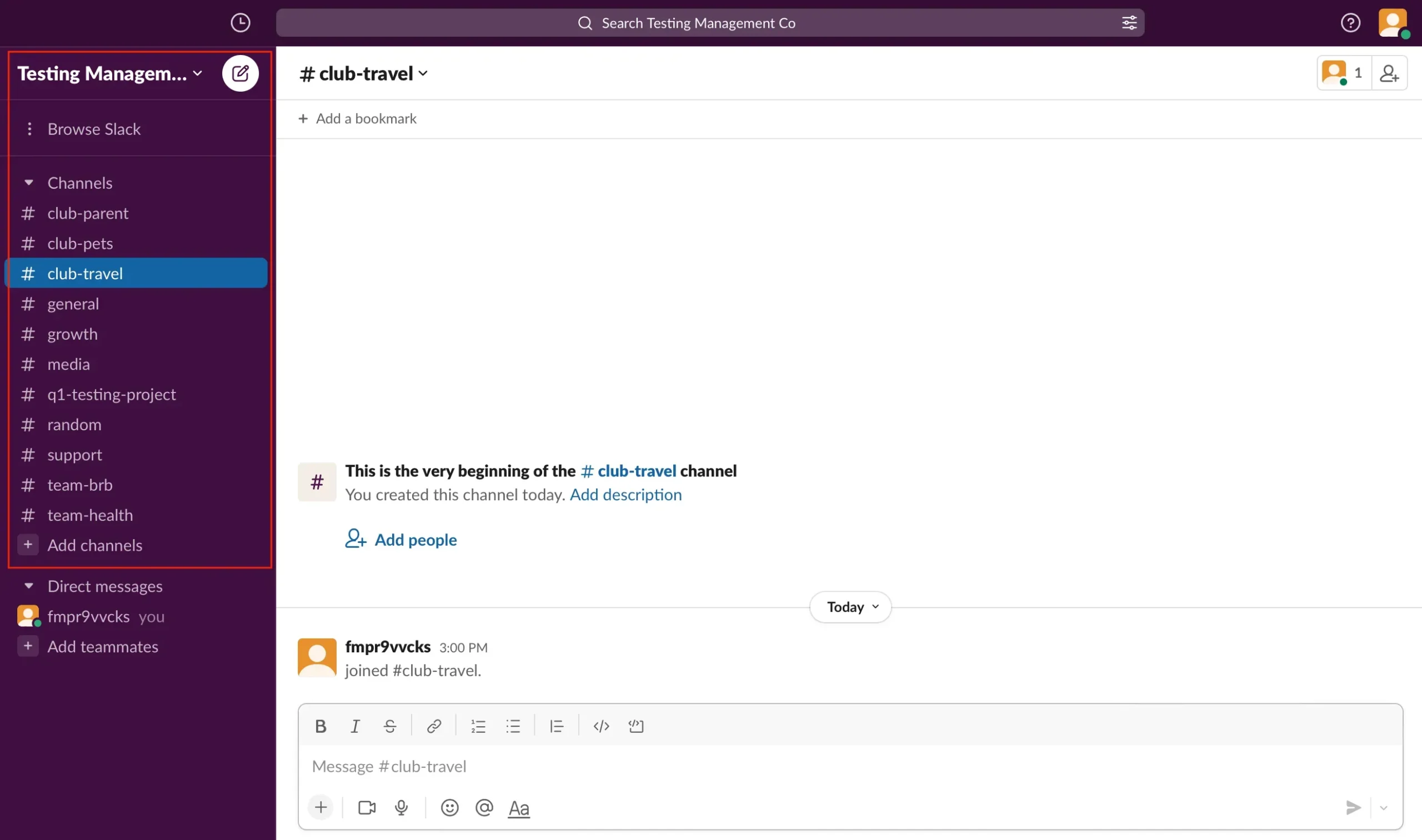
Channel-Based Organization: Separate conversations by project, team, or topic for focused communication
Asynchronous Communication: Thread responses, scheduled messages, and status updates support cross-timezone collaboration
Huddles and Clips: Quick audio conversations and video messages add a personal touch to remote interactions
Workflow Builder: Create custom automation for repetitive processes and team coordination
External Collaboration: Slack Connect enables secure communication with clients and partners
Industry-leading integration ecosystem connects 2,600+ business applications
Superior search functionality helps teams find information across all conversations
Strong mobile app maintains full communication capabilities during remote work
Advanced security features meet enterprise requirements for distributed teams
Powerful API enables custom workflow integrations and automation
Free plan limits message history to 90 days, restricting long-term reference
It can become overwhelming with notification overload if not properly managed
Limited project management features require integration with dedicated tools
Customer Rating: 4.5/5 (G2)
Free Trial: Free plan available with limitations
Starting Price: $8.75/user/month for Pro plan
Key Integrations: Google Workspace, Microsoft 365, Zoom, Asana, Monday.com, Trello, GitHub
Best For: Communication-heavy remote teams needing robust messaging with extensive third-party tool integration
Microsoft Teams has evolved into a comprehensive remote team management platform that seamlessly integrates with the Microsoft 365 ecosystem, making it the natural choice for enterprises already invested in Microsoft technologies. The platform combines communication, collaboration, and coordination tools into a single interface.
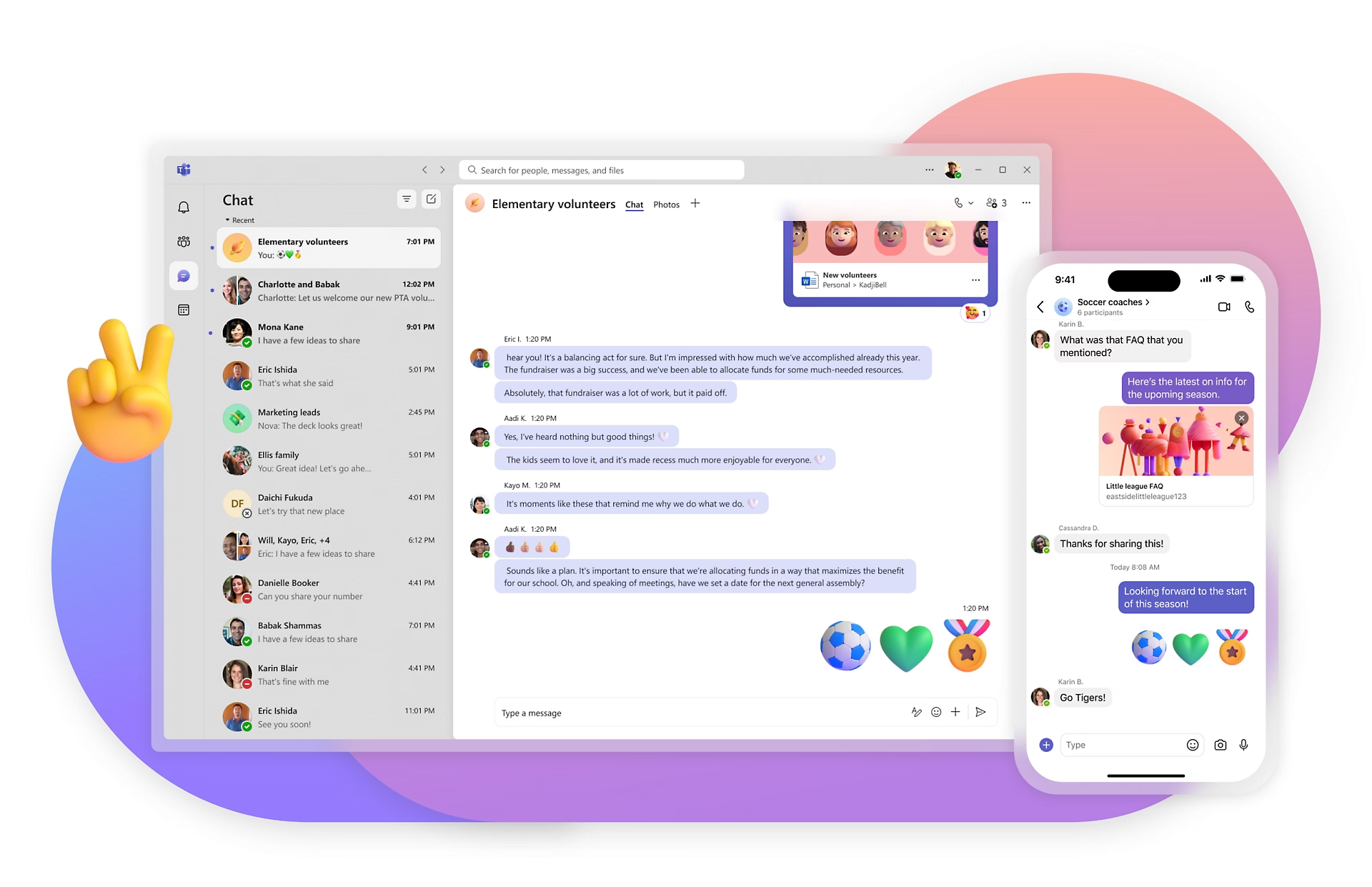
Integrated Video Conferencing: Host meetings for up to 300 participants with recording and transcription capabilities
Office 365 Integration: Real-time co-editing of Word, Excel, and PowerPoint documents within the Teams interface
Channel-Based Collaboration: Organize team discussions by project or topic with persistent chat history
Advanced Security: Enterprise-grade security with compliance features for regulated industries
Power Platform Integration: Create custom apps and automation workflows directly within Teams
Seamless integration with Microsoft 365 creates a unified remote work experience
Enterprise-grade security and compliance meet strict organizational requirements
No learning curve for organizations already using Microsoft products
Comprehensive mobile app supports full remote work functionality
Competitive pricing when bundled with existing Microsoft subscriptions
Limited value for organizations not using the Microsoft ecosystem extensively
Interface can feel cluttered compared to specialized remote team management tools
External collaboration features lag behind dedicated platforms like Slack
Customer Rating: 4.4/5 (G2)
Free Trial: Free version available with limitations
Starting Price: $4/user/month (Microsoft 365 Business Basic)
Key Integrations: Microsoft 365 suite, Adobe Creative Cloud, Salesforce, ServiceNow, Zoom
Best For: Enterprise remote teams already using Microsoft 365 who need integrated communication and collaboration
Notion serves as both a remote team collaboration tool and a comprehensive knowledge management system, excelling when distributed teams need to create, organize, and share information effectively. Its block-based approach to content creation enables teams to build custom workflows that match their exact remote work needs.
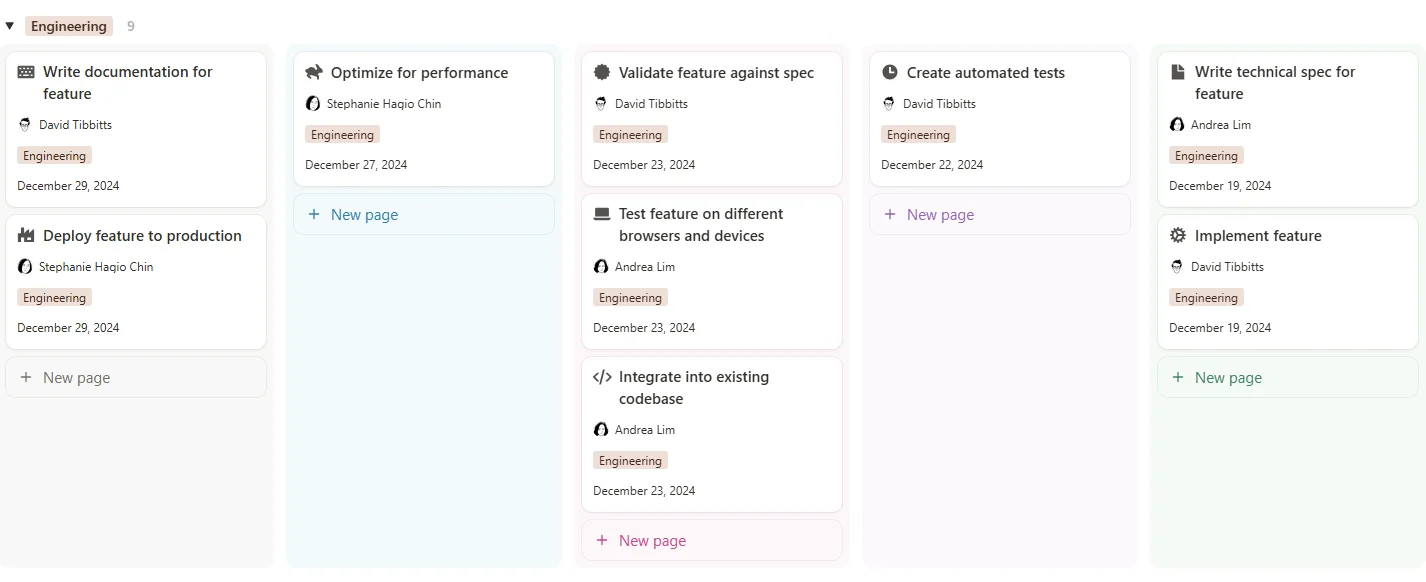
All-in-One Workspace: Combine notes, databases, wikis, and project management in a unified interface
Template Gallery: Pre-built templates for common remote team workflows and project types
Database Functionality: Create custom databases for tracking projects, resources, and team information
Real-Time Collaboration: Multiple team members can edit documents simultaneously with comment threads
AI Writing Assistant: Built-in AI helps draft content, summarize information, and improve writing quality
Highly flexible platform adapts to virtually any remote team workflow requirement
Strong knowledge management capabilities centralize team information and documentation
Generous free plan supports small remote teams with full feature access
Beautiful, clean interface encourages regular use and engagement
Powerful template system accelerates setup for new projects and processes
Steep learning curve due to extreme flexibility and customization options
Performance can slow with large databases and complex page structures
Limited advanced project management features compared to dedicated PM tools
Customer Rating: 4.7/5 (G2)
Free Trial: Personal plan is free forever
Starting Price: $8/user/month for Team plan
Key Integrations: Google Calendar, GitHub, Figma, Slack, Zapier, Typeform
Best For: Remote teams prioritizing knowledge management, documentation, and flexible workspace customization
Basecamp takes a deliberately simple approach to remote team management software, focusing on essential features that keep distributed teams organized without complexity overload. The platform prioritizes human connection and clear communication over feature abundance.
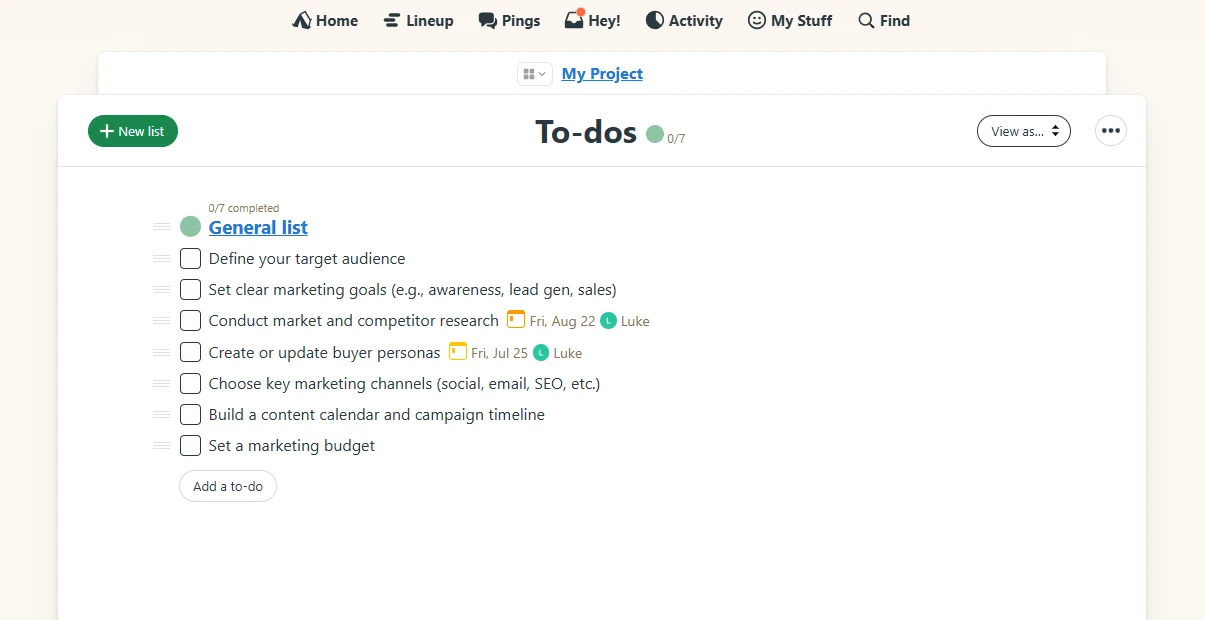
Automatic Check-ins: Regular team updates keep everyone informed about progress and blockers
Message Boards: Threaded discussions replace email chains with organized, searchable conversations
Simple Scheduling: Shared calendars and milestone tracking without overwhelming complexity
Client Access: External stakeholder portals enable collaboration without security concerns
Email Integration: Forward emails directly into Basecamp to centralize communication
Minimal learning curve enables immediate productivity for new remote team members
Human-centric design prioritizes communication and team connection over features
Flat pricing structure ($99/month for unlimited users) benefits larger remote teams
Strong customer support with quick response times and helpful resources
Clean mobile app maintains full functionality for remote work scenarios
Limited advanced features may not meet the needs of complex projects or workflows
No time tracking functionality requires integration with third-party tools
Lacks advanced reporting and analytics capabilities
Customer Rating: 4.3/5 (G2)
Free Trial: 30-day free trial available
Starting Price: $15/user/month (or $99/month flat fee for unlimited users)
Key Integrations: Google Calendar, Outlook, Zapier, email platforms, time tracking apps
Best For: Small to medium remote teams preferring simplicity and human-centered communication over complex feature sets
Wrike caters to the sophisticated needs of distributed teams with enterprise-grade features designed for managing complex projects and detailed resource allocation. The platform excels when remote teams need comprehensive project visibility and advanced workflow control.
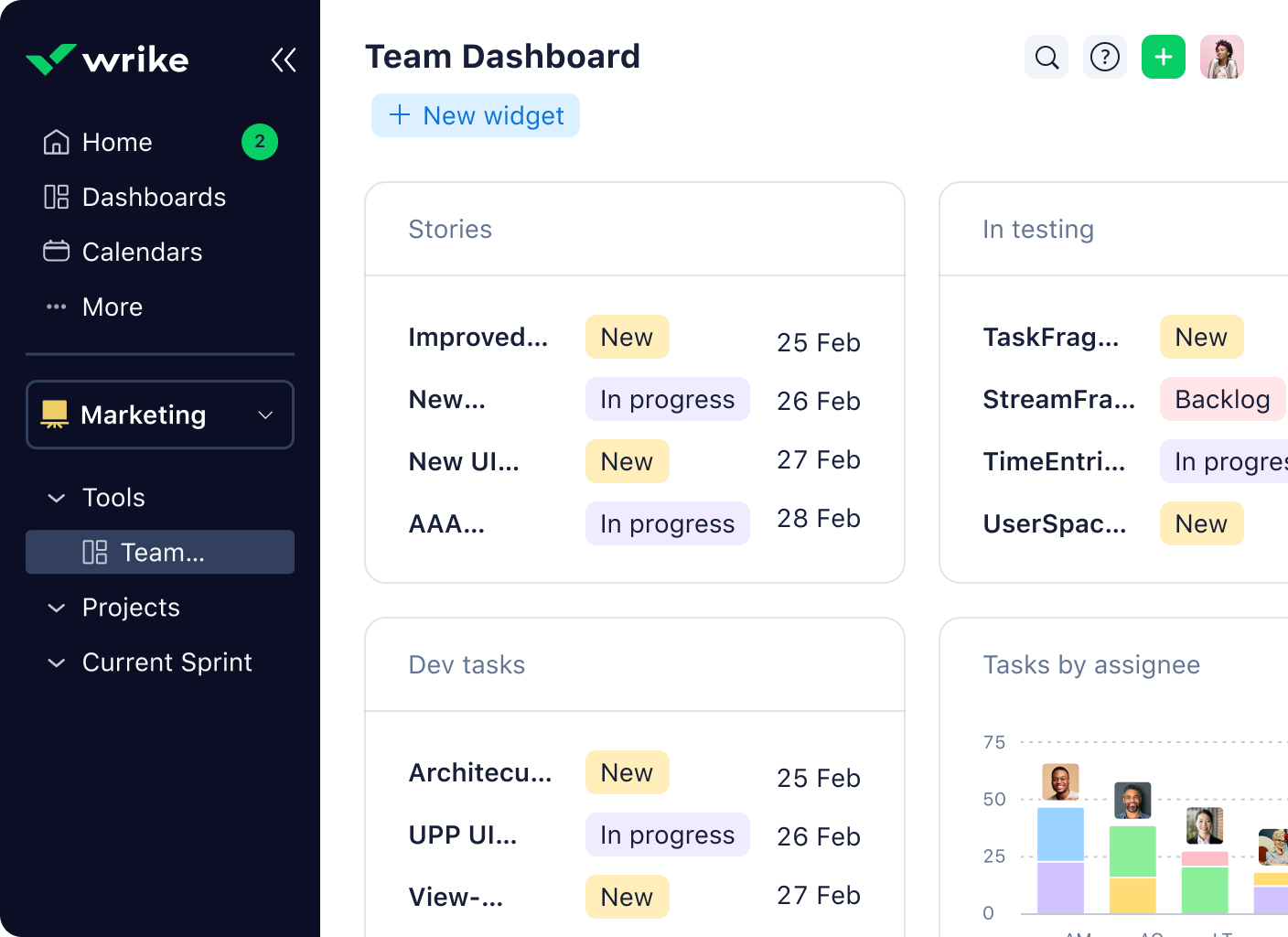
Advanced Gantt Charts: Detailed project timelines with dependency tracking and critical path analysis
Resource Management: Workload balancing prevents team burnout across distributed team members
Proofing System: Collaborative review process for creative assets with markup and approval workflows
Custom Dashboards: Executive-level reporting with real-time project status across multiple teams
Advanced Analytics: Detailed reporting on team performance, project profitability, and resource utilization
Comprehensive feature set handles complex project management requirements effectively
Strong security and compliance features meet enterprise standards for distributed teams
Advanced reporting provides insights for optimizing remote team performance
Robust API enables extensive customization and integration possibilities
Professional services support helps with implementation and optimization
A steep learning curve requires significant training for optimal utilization
A higher pricing point may not justify the costs for simpler remote team needs
Interface complexity can overwhelm users seeking straightforward project management
Customer Rating: 4.5/5 (G2)
Free Trial: 14-day free trial available
Starting Price: $10/user/month for the Professional plan
Key Integrations: Microsoft Teams, Salesforce, Adobe Creative Cloud, Google Workspace, ServiceNow
Best For: Large remote teams and enterprises requiring sophisticated project management with detailed resource tracking and reporting
The effectiveness of remote team management software varies significantly based on organizational size, with each tier facing unique challenges in coordinating distributed teams. Understanding these distinctions helps organizations select platforms that scale with their remote work requirements.
Small distributed teams prioritize simplicity, cost-effectiveness, and rapid implementation over complex feature sets. At this scale, remote teams often struggle with basic coordination—knowing who’s working on what, when deliverables are due, and maintaining clear communication across time zones.
Recommended Tools:
Kanbanchi offers exceptional value, supports unlimited users and boards, along with Google/Microsoft integrations that eliminate learning curves.
Trello offers intuitive visual organization that any remote team member can understand immediately, with scalable pricing as teams grow.
Basecamp simplifies remote coordination with its human-centric approach and flat pricing, which becomes cost-effective as teams grow to 8-10 members.
Key Considerations: Small remote teams need tools that “just work” without extensive setup or training. The ability to start with free plans and scale affordably matters more than advanced features they may never use.
Medium-sized distributed teams face the challenge of coordinating multiple projects simultaneously while maintaining a cohesive team culture and individual accountability. At this scale, informal communication breaks down, requiring structured workflows and clear visibility into team capacity and project status.
Recommended Tools:
Asana excels with structured workflows that keep larger remote teams aligned without micromanagement, as well as portfolio views for managing multiple concurrent projects.
Monday.com offers visual project management that works across various departments and time zones, with automation that minimizes administrative overhead.
Kanbanchi offers comprehensive features that can replace multiple tools, making it essential for teams that need budget efficiency without sacrificing functionality.
Key Considerations: Medium-sized remote teams require platforms that offer structure without excessive bureaucracy.
Large distributed organizations require enterprise-grade remote team management platforms with advanced security, compliance, and administrative controls. At scale, organizations face challenges including data governance, user management, and maintaining consistent workflows across multiple departments and geographic regions.
Recommended Tools:
Microsoft Teams provides enterprise integration with existing Microsoft investments, advanced security, and administrative controls needed for large, distributed workforces.
Kanbanchi offers tools that support any team within the large company and allow them to have a unified platform to collaborate on projects of any comlpexity.
Notion can serve as an enterprise knowledge hub, centralizing information and processes that large, distributed organizations need to maintain consistency.
Key Considerations: Large organizations prioritize security, compliance, and administrative control over simplicity. Integration with existing enterprise systems (SSO, LDAP, security protocols) becomes mandatory rather than optional.
Scalability Insights: The most successful remote organizations begin with simple tools and gradually transition to more sophisticated platforms as their complexity increases. Kanbanchi’s approach of providing enterprise features (Google Workspace integration, security compliance) while maintaining simplicity makes it uniquely positioned to grow with organizations from startup to mid-market scale.
Modern asynchronous communication tools and remote team collaboration platforms must address seven critical capabilities that distinguish effective distributed team management from traditional project management approaches.
Asynchronous communication enables team members to contribute meaningfully without requiring simultaneous availability, which is essential when teams span 12 or more time zones. Effective platforms provide threaded discussions, voice messages, video updates, and document annotation that maintain context across different work schedules.
Implementation Examples: Slack’s thread system keeps conversations organized while allowing delayed responses. Loom integration on various platforms enables detailed explanations through screen recordings that team members can review at their convenience.
Advanced remote team management software automatically adjusts deadlines, meeting suggestions, and task handoffs based on team member locations. The most sophisticated platforms offer visual time zone maps and suggest optimal collaboration windows when global teams have natural time zone overlaps.
Critical Capabilities: Automatic timezone conversion for deadlines, visual time zone displays showing team availability, and intelligent scheduling that finds optimal meeting times across multiple regions.
When teams can’t gather for impromptu status meetings, visual project tracking becomes essential for maintaining project visibility. Effective platforms offer multiple views: Kanban boards, Gantt charts, and Task lists, ensuring every team member can access project status in their preferred format.
Advanced Features: Real-time progress indicators, customizable dashboard views, and visual bottleneck identification that helps remote managers address issues before they impact deadlines.
Distributed team management requires robust mobile functionality. Team members working from various locations, including areas with intermittent connectivity, need access to critical project information and the ability to update progress.
The best remote team collaboration tools serve as central hubs connecting video conferencing, communication platforms, file storage, and specialized business applications. Seamless integration eliminates the need for tool switching, which fragments remote team workflows and reduces productivity.
Maintaining team culture across distributed teams requires intentional features that foster connection and recognition. Advanced platforms include virtual team-building tools, peer recognition systems, and engagement analytics that help managers identify potential issues of isolation.
Engagement Tools: Automated celebration of milestones, peer recognition systems, virtual coffee chat scheduling, and team mood tracking that provides early warning signs of disengagement.
Global team management software must provide enterprise-grade security without impeding collaboration efficiency. This includes end-to-end encryption, granular permission controls, audit logs, and compliance with international data protection regulations (GDPR, SOC2, ISO).
Security Essentials: SSO integration, two-factor authentication, data encryption in transit and at rest, comprehensive audit logs, and compliance certifications relevant to your industry.
The most effective platforms integrate these features seamlessly rather than treating them as separate capabilities. Kanbanchi exemplifies this integration by embedding Google Workspace’s security and collaboration features directly into project management workflows, creating a unified experience that addresses all seven critical areas.
Selecting the optimal remote team management platform requires a systematic evaluation of your team’s specific challenges and growth trajectory in a distributed work environment. The wrong choice can impede productivity for months, while the right platform transforms remote collaboration effectiveness.
Evaluate Current Remote Work Practices: Teams new to remote work need simple, intuitive platforms like Trello or Basecamp that provide immediate value without complexity. Mature remote teams can leverage sophisticated platforms like Wrike or ClickUp that offer advanced workflow automation and analytics.
Consider Geographic Distribution: Teams spanning 2-3 time zones have different needs than truly global operations across 12+ zones. Time zone coordination features become critical for globally distributed teams, making platforms with advanced scheduling capabilities essential.
Audit Current Tool Stack: Map existing applications—such as communication tools (Slack, Teams), storage solutions (Google Drive, OneDrive), and video conferencing platforms (Zoom, Google Meet)—and prioritize those with native integrations. Kanbanchi’s deep Google Workspace integration eliminates friction for Google-centric teams.
Plan for Scalability: Consider future tool additions and whether your chosen platform can accommodate growth. Platforms with robust API capabilities and extensive integration marketplaces provide more flexibility as needs evolve.
Implement Pilot Programs: Run 2-4 week trials with core team members using actual projects rather than generic demos. Pay attention to adoption rates, user feedback, and productivity impacts during typical remote work scenarios.
Measure Specific Outcomes: Track key metrics such as task completion rates, communication frequency, project delivery times, and team satisfaction scores during trials. These quantitative measures provide objective comparison data.
Calculate Hidden Costs: Beyond subscription fees, consider the costs of training time, integration development, and productivity losses during transitions. Free plans, such as those offered by Kanbanchi and ClickUp, can reduce initial costs but may require upgrades as teams scale.
Project Long-term Expenses: Factor in user growth, additional features required over time, and potential switching costs if the platform fails to scale effectively with your organization.
Communication Style: Does your team prefer asynchronous communication or need frequent real-time collaboration?
Technical Expertise: How much setup complexity can your team handle without dedicated IT support?
Compliance Requirements: Do you need specific security certifications or data residency controls?
Growth Trajectory: Will you add team members, projects, or complexity within the next 12-24 months?
Decision Framework Priority:
User Experience: The best features are worthless if team members won’t use them consistently
Integration Fit: Platforms that work with your existing tools reduce friction and increase adoption
Scalability: Choose platforms that can grow with your team rather than forcing future migrations
Support Quality: Remote teams need responsive support when issues arise across different time zones
The most successful remote team implementations combine the right platform choice with proper change management, training, and ongoing optimization based on team feedback and usage analytics.
Kanbanchi’s strength in cross-time zone collaboration stems from its seamless integration with Google Workspace, combined with features specifically designed for asynchronous communication and distributed team coordination. Real-world implementations demonstrate how the platform transforms time zone challenges into competitive advantages.
A digital marketing agency expanded globally by establishing teams in three strategic locations spanning 13 time zones. Using Kanbanchi, they created a “follow-the-sun” workflow that allows projects to progress continuously across all time zones.
Implementation Strategy:
Shared Campaign Boards in Google Drive enable all locations to access the current project status instantly
Google Calendar Integration automatically adjusts task deadlines and milestone dates for each time zone
Gmail-to-Task Creation allows team members to convert client emails into actionable items regardless of when they’re received
Time Tracking across Zones provides visibility into productivity patterns and helps identify optimal handoff timing
Measurable Results:
35% faster campaign delivery due to continuous work progression
60% reduction in “waiting for approval” delays through asynchronous review processes
90% improvement in client satisfaction scores due to faster response times
25% cost savings from eliminating redundant work across locations
A SaaS startup leveraged Kanbanchi to coordinate development sprints across three continents, maintaining agile methodology despite 12+ hour time differences between team members.
Technical Implementation:
Google Sheets Integration provides real-time sprint burndown charts accessible to all developers
Kanban Board Status Updates enable asynchronous daily standups through detailed task comments
Google Drive File Attachments ensure all team members have access to the latest code documentation and design files
Calendar Milestone Sync coordinates release schedules across different regional holidays and work patterns
Development Outcomes:
40% improvement in sprint completion rates through better task visibility
50% reduction in communication delays using asynchronous status updates
75% decrease in scheduling conflicts for cross-team collaboration sessions
30% faster bug resolution through clear handoff documentation
An international business consulting firm utilizes Kanbanchi to manage client projects across North America, Europe, and Asia, ensuring consistent service delivery regardless of the consultant’s or client’s location.
Client Workflow Optimization:
Client-Facing Boards provide transparent project progress without exposing internal discussions
Google Forms Integration captures client feedback that automatically creates follow-up tasks
Time Zone-Aware Scheduling suggests optimal meeting times, considering all stakeholder locations
Multi-language Support through Google Workspace enables teams to collaborate in their native languages
Business Impact:
45% increase in client retention through improved communication transparency
55% reduction in project coordination overhead
65% improvement in consultant utilization rates across time zones
20% growth in international client acquisition due to demonstrated global coordination capabilities
An e-commerce company coordinates product development, manufacturing oversight, and marketing campaigns between teams in Seattle and suppliers across Asia using Kanbanchi’s logistics-friendly features.
Supply Chain Integration:
Product Development Boards track design iterations across 14-hour time differences
Inventory Management through Google Sheets integration provides real-time stock visibility
Quality Control Workflows enable async photo and documentation review of manufacturing processes
Launch Coordination synchronizes marketing campaigns with inventory availability across regions
Operational Results:
30% faster product launch cycles through continuous development workflows
80% reduction in miscommunication-related manufacturing delays
95% improvement in inventory accuracy through real-time tracking
40% increase in successful product launches due to better coordination
Google Workspace Foundation: Teams already using Gmail, Google Drive, and Google Calendar experienced immediate productivity gains without needing to learn new interfaces.
Asynchronous Documentation: Detailed task comments, file attachments, and status updates enable meaningful collaboration without requiring simultaneous availability.
Visual Progress Tracking: Kanban boards provide instant visibility into project status, which is crucial when team members start work at different times.
Seamless Handoffs: Integration with Google Calendar and Gmail ensures smooth task transitions across time zones, preserving complete context.
These case studies demonstrate that Kanbanchi’s approach to remote team management—deep integration rather than standalone features—enables organizations to transform time zone differences from obstacles into operational advantages.
The remote team management software landscape continues evolving rapidly, with emerging technologies reshaping how distributed teams collaborate, communicate, and coordinate across global time zones. Understanding these trends enables organizations to make informed strategic platform decisions that remain relevant as remote work evolves.
Artificial intelligence integration transforms remote team management platforms from reactive tools to predictive systems that optimize team performance proactively. Advanced AI capabilities analyze communication patterns, task completion rates, and collaboration effectiveness to provide actionable insights for remote team leaders.
Current AI Applications:
Intelligent Task Assignment analyzes team member workloads, expertise, and availability to suggest optimal task distribution
Automated Status Updates generate progress summaries from task activities, reducing manual reporting overhead
Predictive Timeline Adjustments identify potential delays based on historical data and current progress patterns
Smart Meeting Scheduling finds optimal collaboration windows across multiple time zones while considering team member preferences
Emerging Capabilities: AI-powered sentiment analysis of team communications can identify potential burnout or engagement issues before they impact productivity. Predictive analytics will soon forecast project risks and suggest mitigation strategies based on similar historical projects.
As VR technology becomes more accessible and affordable, virtual team collaboration environments are emerging that recreate the dynamics of in-person meetings for distributed teams. These immersive spaces address the “presence” challenge that traditional video conferencing cannot solve.
VR Integration Benefits:
Spatial Audio Collaboration enables natural conversation flow with multiple participants
3D Whiteboarding allows teams to manipulate ideas and concepts in three-dimensional space
Virtual Office Environments provide persistent spaces where remote team members can “drop in” for informal collaboration
Gesture-Based Interaction makes virtual meetings feel more natural and engaging than traditional screen-based alternatives
Platform Integration: Forward-thinking platforms are developing VR modules that integrate seamlessly with existing project management workflows, ensuring virtual collaboration sessions automatically sync with task assignments and project documentation.
Global team management software increasingly incorporates sophisticated algorithms that go beyond simple time zone conversion to optimize distributed team workflows. These systems take into account cultural differences, regional holidays, and individual productivity patterns.
Next-Generation Features:
Automated Workflow Orchestration sequences tasks optimally across time zones for continuous project progression
Cultural Context Integration considers regional communication styles and business practices when suggesting collaboration approaches
Dynamic Schedule Optimization adjusts project timelines in real-time based on team member availability and workload
Smart Handoff Documentation automatically generates context-rich summaries when tasks transfer between time zones
As remote work becomes permanent, cybersecurity requirements for distributed team platforms intensify. Future platforms will embed security features seamlessly into collaboration workflows rather than treating security as a separate concern.
Advanced Security Trends:
Zero-Trust Architecture assumes no implicit trust between team members or devices, requiring continuous verification
Behavioral Analytics identifies unusual access patterns that might indicate security compromises
Encrypted Collaboration provides end-to-end encryption for all team communications without impeding usability
Compliance Automation automatically ensures all team activities meet regulatory requirements (GDPR, SOC2, ISO)
Machine learning algorithms will increasingly optimize remote team workflows automatically, learning from successful project patterns to suggest improvements for future initiatives.
Workflow Intelligence Features:
Process Mining analyzes completed projects to identify inefficiencies and suggest optimizations
Resource Allocation Optimization predicts optimal team composition for different project types
Communication Pattern Analysis suggests better coordination strategies based on successful team interactions
Performance Benchmarking provides data-driven insights into team productivity compared to similar organizations
The future favors integrated remote work ecosystems rather than standalone tools. Successful platforms will serve as central hubs connecting communication, project management, document collaboration, and business applications seamlessly.
Integration Trends:
No-Code Automation allows non-technical team members to create sophisticated workflow automation
Cross-Platform Data Sync ensures consistent information across all business applications
Universal Search finds information across all connected tools from a single interface
Kanbanchi’s Position: As a Google Workspace native application, Kanbanchi is uniquely positioned to benefit from Google’s continued investment in AI, collaboration, and cloud infrastructure. The platform’s deep integration strategy aligns with the trend toward ecosystem-based remote work solutions.
These technological advances will democratize sophisticated remote team management capabilities previously available only to large enterprises, enabling small and medium teams to compete effectively in the global marketplace through superior distributed collaboration tools.
For small businesses (2-15 people), Kanbanchi offers exceptional value with its free plan supporting unlimited users and seamless Google Workspace integration. Small teams benefit from zero learning curve, enterprise-grade security through Google’s infrastructure, and the ability to scale affordably as they grow. Trello serves as an excellent alternative for teams preferring visual simplicity over advanced features.
Remote team management software specifically addresses the challenges of distributed work, including asynchronous communication across time zones, mobile accessibility for location-independent work, integration with communication tools (such as Slack and Zoom), and features that maintain team culture even when physical presence is absent. Traditional project management tools primarily focus on task tracking and deadlines, without considering the human elements of remote collaboration.
Critical time zone management features include automatic deadline conversion, visual time zone displays that show team availability, intelligent scheduling that finds optimal collaboration windows, asynchronous communication tools for non-real-time updates, and handoff documentation that provides complete context when tasks are transferred between regions. Kanbanchi’s Google Calendar integration exemplifies effective time zone coordination.
Budget $5-15 per user monthly for small teams, $20-35 for medium organizations, and $30-60 for enterprise solutions with advanced security. Include implementation costs (2-4 weeks reduced productivity), training time (4-8 hours per user), and potential integration expenses. Starting plans from Kanbanchi, ClickUp, and Trello provide excellent starting points for cost-conscious teams.
Yes, Google Workspace integration is crucial for organizations that are primarily Google-centric. Kanbanchi offers the deepest integration – native Google Drive storage, Gmail task creation, Calendar sync, and single sign-on authentication. Asana, Monday.com, and ClickUp offer good Google integration, but they require separate logins and data storage.
Kanbanchi offers the most comprehensive free plan, featuring unlimited users, boards, and Google Workspace integration – ideal for growing teams. ClickUp offers extensive features but with storage limitations. Trello excels in simplicity and visual organization. The “best” choice depends on whether your team uses Google Workspace and needs advanced features.
Track productivity metrics including task completion rates, project delivery times, communication efficiency, and team satisfaction scores. Studies show that well-chosen platforms can improve productivity by 20-35% through better coordination and reduced administrative overhead. Kanbanchi’s Google Sheets integration facilitates ROI tracking by exporting time and productivity data for analysis.
The landscape of remote team management software has matured significantly, with specialized platforms now addressing the complex challenges of coordinating distributed teams, facilitating asynchronous communication, and enabling cross-timezone collaboration. As 22.8% of the US workforce continues working remotely, organizations must move beyond basic project management tools to platforms explicitly designed for the nuances of distributed work.
The best remote team management software for 2025 combines intuitive usability with sophisticated features that address real-world remote work challenges, including maintaining team culture across distances, coordinating projects across multiple time zones, and ensuring productivity without micromanagement. Kanbanchi exemplifies this balance by providing enterprise-grade capabilities through familiar Google Workspace integration, eliminating the learning curve that often impedes remote team adoption of new tools.
Ready to transform your remote team’s productivity? Begin your evaluation by considering platforms that align with your existing technology investments and team preferences. For Google Workspace users, Kanbanchi’s seamless integration and comprehensive feature set provide an ideal foundation for achieving success as a distributed team. Begin with free trials to validate team adoption, then scale selectively based on proven value rather than the abundance of features.
In this Article:
Start using Kanbanchi now
Start your free trial